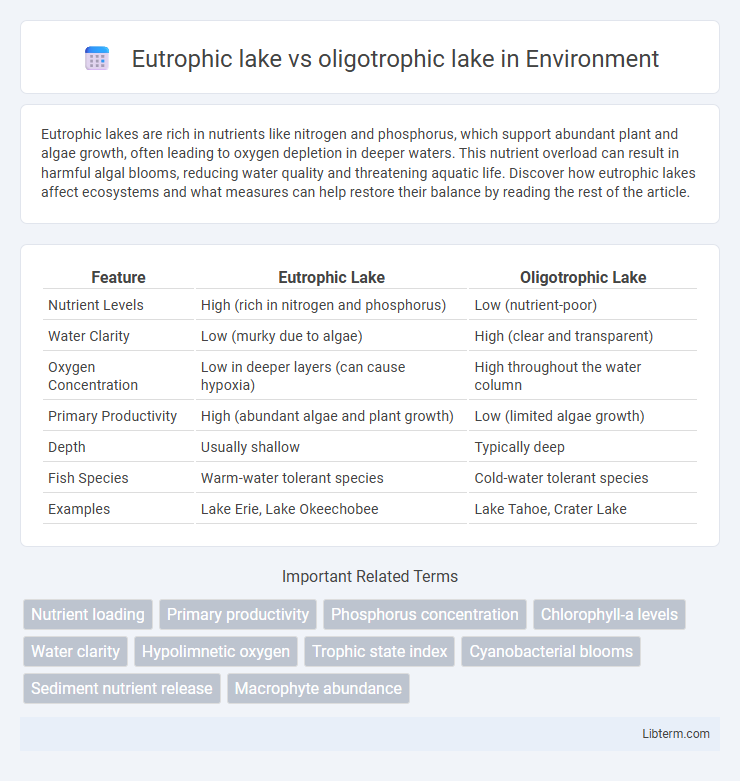Eutrophic lakes are rich in nutrients like nitrogen and phosphorus, which support abundant plant and algae growth, often leading to oxygen depletion in deeper waters. This nutrient overload can result in harmful algal blooms, reducing water quality and threatening aquatic life. Discover how eutrophic lakes affect ecosystems and what measures can help restore their balance by reading the rest of the article.
Table of Comparison
| Feature | Eutrophic Lake | Oligotrophic Lake |
|---|---|---|
| Nutrient Levels | High (rich in nitrogen and phosphorus) | Low (nutrient-poor) |
| Water Clarity | Low (murky due to algae) | High (clear and transparent) |
| Oxygen Concentration | Low in deeper layers (can cause hypoxia) | High throughout the water column |
| Primary Productivity | High (abundant algae and plant growth) | Low (limited algae growth) |
| Depth | Usually shallow | Typically deep |
| Fish Species | Warm-water tolerant species | Cold-water tolerant species |
| Examples | Lake Erie, Lake Okeechobee | Lake Tahoe, Crater Lake |
Introduction to Lake Trophic States
Eutrophic lakes exhibit high nutrient concentrations, primarily nitrogen and phosphorus, leading to abundant plant and algal growth, often resulting in decreased oxygen levels and reduced water clarity. Oligotrophic lakes are characterized by low nutrient availability, clear water, and high oxygen content, supporting diverse fish populations and minimal algal presence. Understanding these trophic states is essential for managing aquatic ecosystems and assessing environmental health.
Defining Eutrophic Lakes
Eutrophic lakes are characterized by high nutrient concentrations, particularly nitrogen and phosphorus, resulting in abundant algal growth and increased biological productivity. These lakes often exhibit low oxygen levels in deeper waters due to organic matter decomposition, leading to hypoxic conditions that can affect aquatic life. In contrast, oligotrophic lakes have low nutrient levels, clear water, and higher oxygen content, supporting different ecological dynamics.
Defining Oligotrophic Lakes
Oligotrophic lakes are characterized by low nutrient concentrations, particularly phosphorus and nitrogen, resulting in clear water and low primary productivity. These lakes typically have high oxygen levels throughout the water column, supporting diverse species of fish adapted to nutrient-poor environments. In contrast, eutrophic lakes contain high nutrient levels, leading to abundant algae growth, reduced water clarity, and oxygen depletion in deeper zones.
Key Differences Between Eutrophic and Oligotrophic Lakes
Eutrophic lakes exhibit high nutrient concentrations, particularly phosphorus and nitrogen, leading to abundant algae growth and reduced water clarity, while oligotrophic lakes have low nutrient levels, resulting in clear water and limited biological productivity. Oxygen concentration differs significantly, with eutrophic lakes often experiencing hypoxic or anoxic conditions in deeper layers during stratification, whereas oligotrophic lakes maintain well-oxygenated waters throughout. Sediment composition also varies, as eutrophic lakes accumulate organic-rich sediments from excessive biological activity, contrasting with the mineral-dominated sediments found in oligotrophic lakes.
Water Quality and Nutrient Levels
Eutrophic lakes have high nutrient levels, particularly nitrogen and phosphorus, leading to dense algae growth and reduced water clarity, which often results in lower dissolved oxygen levels and poor water quality. Oligotrophic lakes exhibit low nutrient concentrations, clear water with high transparency, and well-oxygenated conditions that support diverse aquatic life and superior water quality. The nutrient enrichment in eutrophic lakes promotes eutrophication processes, whereas oligotrophic lakes maintain balanced ecosystems with minimal nutrient-related disturbances.
Biological Diversity and Ecosystem Productivity
Eutrophic lakes exhibit high nutrient levels, supporting abundant plant and algal growth, which results in increased primary productivity but often lower biological diversity due to oxygen depletion in deeper waters. Oligotrophic lakes contain low nutrient concentrations, fostering limited but well-oxygenated habitats that sustain diverse aquatic species adapted to nutrient-poor conditions. Ecosystem productivity in eutrophic lakes is higher but can lead to periodic hypoxia, whereas oligotrophic lakes maintain stable, clear-water environments with balanced biodiversity and consistent oxygen availability.
Common Examples of Eutrophic and Oligotrophic Lakes
Lake Erie and Lake Tai are prominent examples of eutrophic lakes, characterized by high nutrient levels and abundant aquatic vegetation. Crater Lake in Oregon and Lake Tahoe are well-known oligotrophic lakes, noted for their deep, clear waters and low nutrient concentrations. These distinct nutrient statuses significantly influence the aquatic ecosystems and water quality in these lakes.
Environmental Impacts and Human Influences
Eutrophic lakes, characterized by high nutrient levels and dense algal blooms, often experience oxygen depletion that threatens aquatic biodiversity and disrupts ecosystem balance. Oligotrophic lakes maintain low nutrient concentrations, supporting clearer water and higher oxygen levels favorable to cold-water fish species, but are vulnerable to nutrient enrichment from agricultural runoff and urbanization. Human activities such as fertilizer application, wastewater discharge, and land-use changes accelerate eutrophication in oligotrophic lakes, exacerbating water quality degradation and promoting harmful algal blooms.
Management and Restoration Strategies
Eutrophic lakes require active management strategies such as nutrient load reduction through controlling agricultural runoff, implementing buffer zones, and enhancing aeration to prevent algal blooms and hypoxia. Oligotrophic lakes benefit from preservation efforts that maintain low nutrient inputs and protect natural vegetation to sustain water clarity and biodiversity. Restoration of eutrophic lakes may involve sediment dredging and biomanipulation, while oligotrophic lakes focus on monitoring and preventing nutrient enrichment to avoid ecosystem degradation.
Conclusion: Choosing Between Eutrophic and Oligotrophic Lakes
Eutrophic lakes are nutrient-rich, supporting abundant aquatic life but often suffering from algae blooms and low oxygen levels in deeper waters. Oligotrophic lakes have low nutrient concentrations, clear water, and high oxygen content, fostering diverse fish populations but generally less biomass. Selecting between eutrophic and oligotrophic lakes depends on ecological goals, such as prioritizing biodiversity and water clarity in oligotrophic lakes or maximizing productivity and fish yield in eutrophic systems.
Eutrophic lake Infographic

 libterm.com
libterm.com